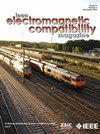Design and Failure Mechanism Analysis of a High-Power Limiter at DC-6 GHz With GaAs PIN Technology
IF 2
3区 计算机科学
Q3 ENGINEERING, ELECTRICAL & ELECTRONIC
IEEE Transactions on Electromagnetic Compatibility
Pub Date : 2024-11-27
DOI:10.1109/TEMC.2024.3493458
引用次数: 0
Abstract
This article examines the electrical-thermal-stress effects of a high-power handling limiter operating at DC-6 GHz, utilizing gallium arsenide positive-intrinsic-negative (PIN) technology for protection against intentional electromagnetic interference. The limiter's performance is evaluated under high-power microwave induced pulse injection at 2 GHz, with varying pulse widths and a pulse repetition frequency (PRF) of 50 Hz. Destruction of the limiter is observed when the pulse width and input power reach 3基于GaAs PIN技术的dc - 6ghz大功率限幅器设计及失效机理分析
本文研究了工作在DC-6 GHz的大功率处理限幅器的电-热-应力效应,该限幅器利用砷化镓正本质负(PIN)技术来防止故意的电磁干扰。在2 GHz高功率微波诱导脉冲注入、不同脉冲宽度和50 Hz脉冲重复频率(PRF)条件下,对该限幅器的性能进行了评估。当脉冲宽度和输入功率分别达到3 μs和63 dBm时,限制器被破坏。从三个方面分析了其失效机理。首先,通过对PIN二极管的等效电路分析,了解限幅器微带线的热分布。还研究了限幅器在不同频率下的特性,重点研究了限幅器输入端的PIN二极管的功率水平。此外,由于在输入端口附近的两个PIN二极管上观察到热致变色的差异,因此通过在分析中考虑温度边界条件和吸收功率来比较它们的热效应和应力效应。在更高的PRF (100 kHz)下进一步探索PIN二极管中的热积累。最后,考虑了限幅器输入端附近的热和应力对键合线互连的影响。测量后的观察显示,键合线和PIN二极管都有损坏,表明键合线在PIN二极管之后失效。
本文章由计算机程序翻译,如有差异,请以英文原文为准。
求助全文
约1分钟内获得全文
求助全文
来源期刊
CiteScore
4.80
自引率
19.00%
发文量
235
审稿时长
2.3 months
期刊介绍:
IEEE Transactions on Electromagnetic Compatibility publishes original and significant contributions related to all disciplines of electromagnetic compatibility (EMC) and relevant methods to predict, assess and prevent electromagnetic interference (EMI) and increase device/product immunity. The scope of the publication includes, but is not limited to Electromagnetic Environments; Interference Control; EMC and EMI Modeling; High Power Electromagnetics; EMC Standards, Methods of EMC Measurements; Computational Electromagnetics and Signal and Power Integrity, as applied or directly related to Electromagnetic Compatibility problems; Transmission Lines; Electrostatic Discharge and Lightning Effects; EMC in Wireless and Optical Technologies; EMC in Printed Circuit Board and System Design.

 求助内容:
求助内容: 应助结果提醒方式:
应助结果提醒方式:


